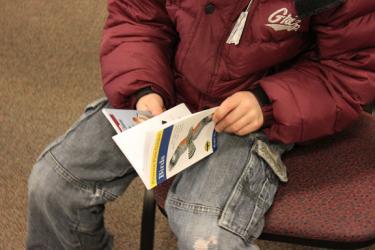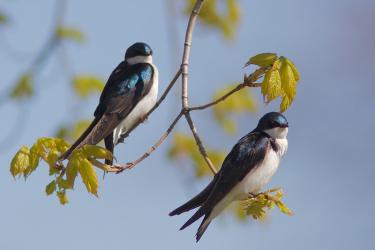Bird ID Basics
Chances are, you already know the names of the most common birds found on your land, the robins, blue jays and cardinals. But if not, the process of identification for all birds can be broken down into a few easy steps.
1. Spend some time reading your guide book
Even before you step outside, it is helpful to sit down with your field guide and get a sense of what birds you are likely to see on your land. There are almost 900 different types of birds in the US, and each one has different plumages for males and females, juvenile birds and different seasons. Identifying what you see is much easier if you first narrow down the possibilities for what you are likely to see. There are several ways to do that:
- Range: You can immediately narrow the identification prospects by looking at its range map in your guide book. If a bird species doesn’t occur in your area, you are not likely to see it. This is why a local bird guide is very helpful, because it only shows the birds likely to be seen in your region.
- Season: Because birds are highly mobile, and many are migratory, the birds you see in spring are not necessarily the same ones you see in summer winter and fall. By using your field guide, and some of the great online tools listed on this website, you can become acquainted with which birds are year-round residents on your land, and which may be stopover guests on their long migrations.
- Habitat: Your field guide will also tell you what type of habitat a bird frequents. If you see a bird in a wetland, you will know it is not likely a bird described as spending most of its time in the upper canopy. And if you are hoping to see a wood thrush, you will know to look in shady forest areas with dense under-story.
- Bird anatomy: By acquainting yourself with your guidebook, you will notice that there are special terms, like crown, cap and other terms that are used to refer to the parts of a birds body or plumage. Getting to know these terms will help you take better notes and more quickly identify birds, whether through the guide or with the help of other birders.
2. Focus on characteristics that are helpful in identification
This may seem obvious, but some characteristics are more helpful in identifying birds than others. For instance, you may notice that a bird is red, or has some red. This is helpful information, but there are many different birds with red feathers, of many different shades. However if you can determine which part of the bird is red, that narrows things down considerably.
Helpful characteristics to note:
- Size and shape: Judge the bird’s size in comparison to a very familiar bird, like a crow or robin. And consider whether the bird is long and tall, or short and round, or use some other way to describe the shape—perhaps in relation to another bird you know. If possible, observe the shape of the bird’s beak and tail, which are often useful in identification.
- Behavior: Notice how the bird is acting. What it is eating? How does it fly? Is it alone, or in a group?
- Color patterns and shapes: Make note of patterns and colors and where they appear on a bird. You may notice white bars on the wings, a dark line through the bird’s eye area, or a yellow cap. All of this is helpful information. One thing to remember, depending on the season, the sex and age of the bird, colors and patterns may be different in the same type of bird. It is generally easiest to identify an adult male, whose plumage is often boldest.
- Song: In addition to helping you find birds, their songs can help distinguish them. Sometimes birds that look very similar have very different songs, helping you to determine which bird is which. So pay attention to how a bird sounds, as well as how it looks. Note: There are special tools you can get, including audio recording CDs and mobile applications, that can help you learn bird songs.
3. Take notes on what you see and hear
When you are out on a birding walk, take notes. Note the color patterns, behaviors, and the habitat you found the bird in—maybe even make a rough sketch. This practice will help you later when you return home and have time to take a longer look at your field guide. You will not likely remember the details of every bird you have seen, and your notes will aid tremendously in finding an identification, either in your guide book, or by asking birding experts. Taking notes also helps you train your eye for the details of bird appearance and helps you remember bird terminology—which will help you become a better birder. Your notes can also be a valuable memory of all the birds you see during your life as a birder.
Find out More
- Bird identification tips—This section of the Cornell website is devoted especially to helping you learn how to identify birds.
-
eBird has fantastic data compiled and presented in charts and maps that show the prevalence of different bird species at different times of year in locations all over the country. You can search for your location and for particular birds to find out if you are likely to see a given species on your land.
How can I get more tips?
It’s simple! Enter your email below.


